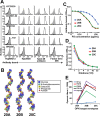New pneumococcal serotype 20C is a WciG O-acetyltransferase deficient variant of canonical serotype 20B
- PMID: 39612217
- PMCID: PMC11705870
- DOI: 10.1128/spectrum.02443-24
New pneumococcal serotype 20C is a WciG O-acetyltransferase deficient variant of canonical serotype 20B
Abstract
The polysaccharide (PS) capsule of Streptococcus pneumoniae (pneumococcus) is the immunodominant surface structure that shields the bacteria from the host immune system. Since the capsule is the primary target of currently available pneumococcal vaccines, anti-capsular antibodies are highly protective but serotype-specific. Pneumococci may evade host or vaccine-induced immunity as a result of variation in capsule structure mediated via multiple mechanisms, such as the loss or gain of O-acetylation. Previous biochemical studies of serogroup 20 isolates have identified two subtypes-20A and 20B, whose capsule PS differs in the WhaF-mediated glucose side chain. Herein, we characterize a newly discovered capsule type, 20C, that differs from serotype 20B via the inactivation of capsule O-acetyltransferase gene, wciG. Structural analysis demonstrated that 20C and 20B share an identical repeat unit [→3)-α-D-GlcpNAc-[β-D-Galf-(1→4)][α-D-Glcp-(1→6)]-(1→P→6)-α-D-Glcp-(1→6)- β-D-Glcp-(1→3)-β-D-Galf 5,6Ac2-(1→3)-β-D-Glcp-(1→], except for the absence of WciG-mediated O-acetyl group at terminal galactofuranose (β-D-Galf). We confirmed that deletion of the wciG gene in a 20B strain resulted in the expression of the 20C capsule. Serotype 20C is serologically indistinguishable from the canonical 20A and 20B using conventional serotyping antibodies, but serogroup 20 subtypes can be distinguished by sequencing of cps genes-whaF, wciG, and wcjE. While genetic screening suggests 20C to be globally less prevalent, a new variant was identified which appears to have both wciG and whaF genes inactive, potentially indicating it to be a new serotype. Consequently, genome-based serotyping/bioinformatic tools must scrutinize all cps genes for mutations that might inactivate/modify cps-encoded enzymes, ensuring effective tracking of emerging capsule variants in response to ongoing vaccination efforts.
Importance: Streptococcus pneumoniae (pneumococcus) is a significant human pathogen known for producing a wide array of antigenically and structurally diverse capsule types, a fact that poses a serious challenge to the effectiveness of vaccines targeting pneumococcal capsule polysaccharide (PS). Herein, we provide a comprehensive analysis-genetic, antigenic, and biochemical of a newly identified capsule type, 20C, which differs from the canonical serotype 20B due to the inactivation of the capsule O-acetyltransferase gene, wciG. Our findings highlight how pneumococci can alter their capsule PS structure and immunological characteristics through minor genetic modifications. Since the appearance of new capsule types can directly affect pneumococcal conjugate vaccine (PCV) implementation, a deeper understanding of capsule PS at the genetic, immunological, and biochemical levels is critical for the development of future diagnostic tools and vaccines.
Keywords: O-acetyltransferase; Streptococcus pneumoniae; capsule polysaccharide; serogroup 20; vaccine.
Conflict of interest statement
UAB has Intellectual Property Rights on some reagents used in the study. J.Y., F.A.G., and M.H.N. are UAB employees. P.D. and R.L. are employees of Vaxcyte, which had no role in the design of this study. The authors declare that they have no other relevant conflicts of interest.
Figures




References
-
- Wahl B, O’Brien KL, Greenbaum A, Majumder A, Liu L, Chu Y, Lukšić I, Nair H, McAllister DA, Campbell H, Rudan I, Black R, Knoll MD. 2018. Burden of Streptococcus pneumoniae and Haemophilus influenzae type b disease in children in the era of conjugate vaccines: global, regional, and national estimates for 2000–15. Lancet Glob Health 6:e744–e757. doi:10.1016/S2214-109X(18)30247-X - DOI - PMC - PubMed
-
- Liu L, Oza S, Hogan D, Chu Y, Perin J, Zhu J, Lawn JE, Cousens S, Mathers C, Black RE. 2016. Global, regional, and national causes of under-5 mortality in 2000–15: an updated systematic analysis with implications for the Sustainable Development Goals. Lancet 388:3027–3035. doi:10.1016/S0140-6736(16)31593-8 - DOI - PMC - PubMed
-
- Yother J. 2004. Capsulep 30–48. In Tuomanen EI, Mitchell TJ, Morrison DA, Spratt BG (ed), The pneumococcus. ASM press, Washington DC.
MeSH terms
Substances
Grants and funding
LinkOut - more resources
Full Text Sources

